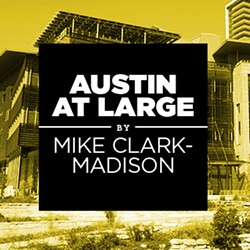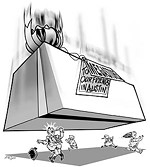Austin @ Large: The Writing on the Wall
Neighbors need to start praising smart growth, before it buries them
By Mike Clark-Madison, Fri., Dec. 19, 2003

Ever since I started writing about neighborhoods, and at more-or-less the same time got involved in my own neighborhood's affairs, I (and my friends and colleagues and editors and neighbors) have been alert to the potential for such conflicts. In this case, I have to explain myself before the City Council on Jan. 8, so I need not do so here. But it's a close-to-home example of the challenge facing those who are gladdened by the ECT survey's validation of a future free of road addiction, land waste, and resegregation. The people who support the ideas behind Smart Growth, or New Urbanism or neo-traditional development or whatever we're calling it today, often also support the biggest role possible for citizens, in their neighborhoods, in shaping land use and urban design. But neighborhoods don't like Smart Growth. (We're talking about the infill-and-redevelopment part of Smart Growth here, not the incentives part. Neighborhoods don't like the incentives either, but for different reasons.)
That's why the erstwhile queen of Smart Growth, City Manager Toby Futrell her own self, threw great vats of cold water toward (if not actually on) ECT during the survey period in the fall, suggesting in several forums (including an audience of homebuilders) that neighborhoods would never accept the density called for in ECT's "alternative" scenarios. Unlike the homebuilders themselves -- whose political functionaries, along with other real estate types, have long argued that people actually like sprawl, traffic jams, dirty air, ugly and cheaply built houses, uglier big-box power centers with massive front-loading parking lagoons, and all the rest -- ECT has not automatically made a liar out of Toby Futrell. What people say they want in the abstract, for the region, really is different from what they want next door. What can we do to change that?
Oxen to Be Gored
Sure, in individual cases -- this superduplex, that Villas on Guadalupe, the other end of my own neighborhood -- we can spin the details and illustrate why exceptions should be made to the all-density, all-the-time dispensation of Smart Growth. But to do that ethically, we have to acknowledge that Toby knows whereof she speaks. Yes, there are examples of neighborhoods embracing density, including (perhaps more than most) Central East Austin. But there are also plenty of examples of the reverse, including Birkenstock Belt precincts where people can get pretty snotty about bashing the insufficiently progressive.
So what else is new? Well, when Toby Futrell's patience is starting to fray, you can be sure that less saintly souls in City Hall have already gone around the bend. If, as is still widely held in many corners of Central Austin, the "neighborhood agenda" is essentially anti-density and anti-Smart Growth, then the current City Council majority -- at least four, sometimes five votes -- is "anti-neighborhood." This seems to me a tragic fate, since the organized neighborhoods of Central Austin, more than any other single constituency, brought you the Green Machine and the progressive consensus that still holds sway at City Hall. (Some urban-core types think that consensus has evaporated. They need to get out more. If the most conservative council member is Betty Dunkerley, then City Hall still leans pretty freakin' far to the left.)
If these same neighborhoods fumble the ball on the issues and cases closest to home, the political consequences could be a lot more far-reaching and dire than a few superduplexes. But even if not, the writing is still on the wall. Expect, for example, that the ECT results will be used to justify a new effort to apply the city's Smart Growth "infill tools" -- garage apartments, small-lot homes, etc. -- citywide, as they were originally intended, and not options to be accepted or rejected in individual neighborhood plans, as they are now. This would not spell the doom of civilization in Central Austin, but it would piss off some of my neighbors, and probably yours as well.
Building Consensus
That's why at least some urban-core leaders -- they know who they are -- have carped and fussed about ECT since its outset three years ago. They knew this would happen. They would like to believe the ECT process was somehow cooked by the evil forces of Smart Growth to achieve its result, thus justifying their continued demand that their neighborhoods be kept free of any kind of change, no matter how plainly beneficial those changes are to the city.
Those leaders may already know I have little sympathy for them, and despite the conspiracy theories, I think ECT bears me out. Indeed, I think they've already given the "neighborhood agenda" a reputation that's almost as bad as that of Smart Growth. Because too many urban neighbors have been too stubborn or selfish or stupid, City Hall is now itching to overreact in the opposite direction, giving carte blanche to truly dumb infill projects (like superduplexes and the Villas) in vast numbers, here, there, and everywhere, and eliminating the power of neighborhoods like mine to try to craft nuanced solutions.
Like I said, I feel my own Central East neighbors have done rather well at thinking about, and advocating for, those kinds of infill projects that have worked and will work, and where and when and why and for whom. (And thus have earned the right to say no once in a while.) We should not be unique. Perhaps all neighborhoods could make a New Year's resolution to support (at least) one dense infill project for every one we oppose. We need to advocate, now, for the infill that is Smart for us, and as much of it as possible -- and cease whining, perhaps forever more, about "preservation" and "neighborhood character" and "property values" and such. Soon, it will be too late.
Got something to say on the subject? Send a letter to the editor.










